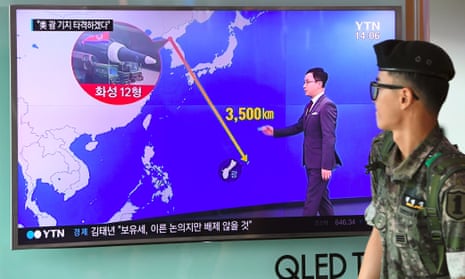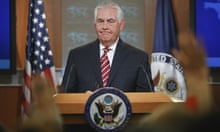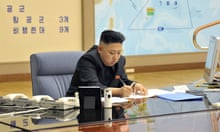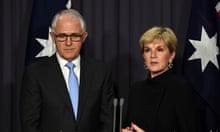North Korea has defied threats of “fire and fury” from Donald Trump, deriding his warning as a “load of nonsense” and announcing a detailed plan to launch missiles aimed at the waters off the coast of the US Pacific territory of Guam.
A statement attributed to General Kim Rak Gyom, the head of the country’s strategic forces, declared: “Sound dialogue is not possible with such a guy bereft of reason and only absolute force can work on him”. The general outlined a plan to carry out a demonstration launch of four intermediate-range missiles that would fly over Japan and then land in the sea around Guam, “enveloping” the island.
“The Hwasong-12 rockets to be launched by the KPA [Korean People’s Army] will cross the sky above Shimani, Hiroshima and Koichi prefectures of Japan,” the statement said. “They will fly for 3,356.7 km for 1,065 seconds and hit the waters 30 to 40km away from Guam.”
The statement said the plan for this show of force would be ready by the middle of this month and then await orders from the commander-in-chief, Kim Jong-un.
The statement was clearly designed as a show of bravado, calling the Trump administration’s bluff after the president’s threat and a statement from the defence secretary, James Mattis, both stressing the overwhelming power of the US military. “North Korea best not make any more threats to the United States. They will be met by fire and fury like the world has never seen,” Trump said on Wednesday.
The response from Pyongyang was its most public and detailed threat to date, and evidently meant to goad the US president. Trump had “let out a load of nonsense about ‘fire and fury’ failing to grasp the ongoing grave situation. This is extremely getting on the nerves of the infuriated Hwasong artillerymen of the KPA.”
The US has a naval base in Guam and the island is home to Andersen air base, which has six B-1B heavy bombers. According to NBC news the non-nuclear bombers have made 11 practice sorties since May in readiness for a potential strike on North Korea. The remote island is home to 162,000 people.
Q&AWhy is North Korea threatening Guam?
Show
Guam, a 210 sq mile sovereign US territory in the western Pacific Ocean, is used by America as a strategic military base. Almost a third of its land is controlled by the US military and about 6,000 American troops are based there.
The island's location, within range of North Korean medium- and long-range missiles, and military significance to the US make it a logical target for Pyongyang.
As recently as Monday, two US air force B-1B bombers flew from Guam to join their counterparts from South Korea and Japan for a mission over the Korean peninsula, about 2,100 miles away. Read more
South Korea’s military said on Thursday that North Korea’s statements were a challenge against Seoul and the US-South Korea alliance. Joint chiefs of staff spokesman Roh Jae-cheon told a media briefing that South Korea was prepared to act immediately against any North Korean provocation.
Japan’s chief government spokesman said the country could “never tolerate this”. “North Korea’s actions are obviously provocative to the region as well as to the security of the international community,” Yoshihide Suga said.
The announcement on the North Korean state news service KCNA came at the end of two days of brinksmanship which began with the leak of a US intelligence report that Pyongyang had developed a nuclear warhead small enough to put on a missile. This was followed by Trump’s warning of “fire and fury”. On Wednesday the US defence secretary, James Mattis, said a North Korean attack would risk the “end of its regime and the destruction of its people”.
On Thursday, Trump’s deputy assistant, Sebastian Gorka, declined to tone down the rhetoric, warning Pyongyang: “Do not challenge the United States because you will pay a cost if you do so”
Asked if the threat of a strike, rather than an actual attack, would be enough to provoke a response, Gorka told the BBC: “If you threaten a nation, then what should you expect; a stiffly worded letter to be sent by courier? Is that what the UK would do if a nation threatened a nuclear-tipped missile launched against any of the UK’s territories?”
Damian Green, the UK’s first secretary of state, urged the Trump administration to use UN processes to resolve the crisis. “It’s obviously in all our interests to make sure that nothing escalates,” Green said on a visit to Edinburgh. “We are very strongly in support of the UN process, which has and continues to put pressure on North Korea to stop acting in an irresponsible way.”
In the event of a missile launch by North Korea, the US military faces the dilemma of trying to intercept the incoming missiles and risking humiliation if it fails. Trump would have to decide whether to try to carry out a pre-emptive strike on the Hwasong launchpads or a retaliation strike if the launch went ahead. The North Korean military has frequently tested missiles that land in the sea off the Japanese coast, without a military response from Tokyo.
“For the [North Koreans] to telegraph a move like this is extraordinary. But it’s probably their way of trying not to trigger a war,” said Joshua Pollack, a senior research associate at Middlebury Institute of International Studies at Monterey. He said that if the launch went ahead as laid out in the statement, it gave US the opportunity to concentrate its ballistic defences in that area, to give them a better chance to shoot down the incoming missiles.
“The reason you can’t shoot down a test is that it doesn’t enter a defended area. But that wouldn’t be the case with ‘bracketing fire’,” Pollack said in a thread of tweets. He argued that the exchange of threats and the missile plans underlined the need to open a military hotline between the US and North Korea to mitigate the dangers of catastrophic miscalculation by either side.
“If they do carry out that plan, both sides might discover that they need a crisis management mechanism sooner than not,” Pollack said.
Q&AWhat are North Korea's nuclear capabilities?
Show
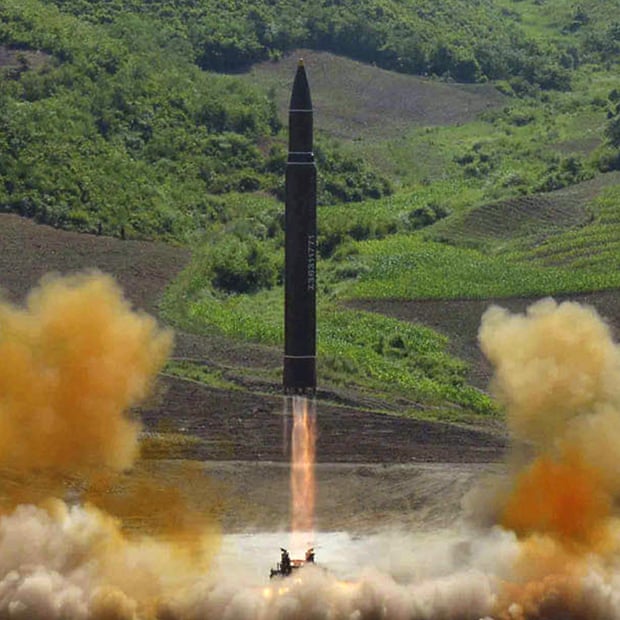
North Korea has carried out five nuclear tests since 2006, so it unquestionably has the capacity to create some form of nuclear bomb.
To function effectively, however, the bomb needs to be small enough to fit on to a missile. Some experts believe the North has already "miniaturised" its nuclear capability, while others believe the regime is still several years away from being able to do so. Japan's defence ministry warned on 8 August that it was possible that Pyongyang had mastered miniaturisation.
North Korea would also need a reliable delivery system for any bomb. Its proven short- and medium-range missiles could reach South Korea and Japan. In July it test-launched two intercontinental ballistic missiles, placing US cities in range of potential attack, according to US experts.
Mattis’s reminder to Pyongyang that the allied militaries “possess the most precise, rehearsed and robust defensive and offensive capabilities on Earth” capped an unprecedented 24 hours of sabre-rattling sparked by Donald Trump’s surprise threat to rain “fire and fury” down on the Pyongyang regime.
Despite the harsh rhetoric, there was no change in US military deployments or alert status. Mattis couched his remarks in the language of traditional deterrence, making clear that such overwhelming force would be used in the event of a North Korean attack.
Trump – without consulting his own security staff – had warned of a devastating onslaught “like the world has never seen” if Kim’s government persisted in threats against the US. But that line was crossed within hours when Pyongyang announced it was “carefully examining” a plan for a missile strike and “enveloping fire” around Guam.
The US secretary of state, Rex Tillerson, also spent much of Wednesday struggling to contain the fallout from Trump’s threats, assuring Americans they could “sleep well at night”, and reassuring shocked allies that there was “no imminent threat of war”.
